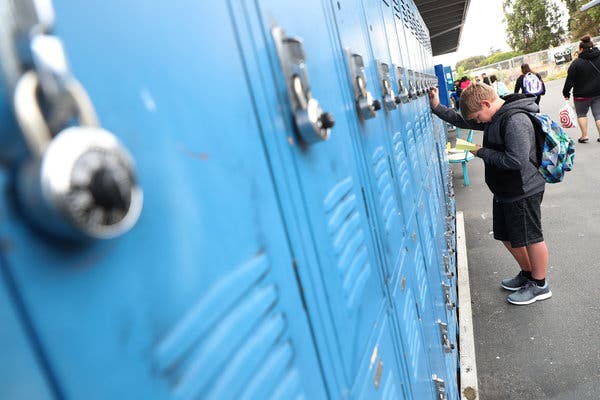
A new law pushed back start times at most public middle and high schools, citing research that says attendance and performance will improve if teenagers get more sleep.

California students can look forward to extra sleep in the morning once a new law takes effect.
The law, signed on Sunday by Gov. Gavin Newsom, pushes back the start times at most public middle and high schools, making California the first state to order such a shift.
Classes for high schools, including those operated as charter schools, will start no earlier than 8:30 a.m. under the law, and classes for middle schools will start no earlier than 8 a.m.
The law, which came amid rising worries about the effects of sleep deprivation on young people, is intended to improve attendance rates and reduce tardiness, said Anthony J. Portantino, a Democratic state senator who wrote the bill.
“Everybody is looking for a magic bullet with education, one that cuts across all demographics, all ethnicities and that actually has a positive, measurable increase in test scores, attendance and graduation rates without costing money,” he said in a telephone interview. “And this is it.”
One supporter of the law: 16-year-old Libby Vastano, a senior from Los Altos, Calif., who starts school around 8 a.m. and said the change would make students happier and less stressed.
“I don’t know many kids that do sleep enough at my high school,” she said. “If you meet someone who gets nine hours, it’s like, ‘Wow.’” Often, she hopes that her first classes in the morning are not the hardest because she still feels groggy.
Sleep experts also hailed the move. Dr. Sumit Bhargava, a clinical associate professor of pediatrics at Stanford University and specialist in pediatric sleep medicine at Stanford Children’s Health, called the law a “triumph,” noting that adolescents’ brains are still developing and that chronic sleep deprivation increases the risk of diseases later in life.
Although it might not seem like much, he said, “the effects of that one hour is something they will be feeling as 40-year-old adults,” adding that students would feel less anxious and less depressed and perform better academically. “When you give them the gift of increased sleep time, it is the biggest bang for buck that you can think about,” he said.
Critics of the bill had pointed to the additional commuting challenges that students could face. They also had argued against a one-size-fits-all approach, citing the potential for disruption to drop-off and pickup times and the disproportionate effects the law would have on working parents. After-school extracurricular activities could also be pushed later in the evening.
“While it may be easy enough for some families with flexible schedules to adjust, in some communities, parents who are working just to make ends meet don’t have the luxury of delaying the start of their workday,” Al Mijares, the superintendent of schools in Orange County, wrote in an opinion piece on Oct. 4.
Schools in the state must put the new law in place by July 1, 2022, or by the expiration date of any district or charter school’s bargaining agreement that is in effect on Jan. 1, 2020. The law does not include optional class periods called “zero periods,” which start before the regular school session. The end of the school day may now be later, but will be determined by individual school districts.
California has more than three million public middle and high school students, and about three in four start school before 8:30 a.m., according to a 2011-12 estimate. The average start for those schools in California was 8:07 a.m. at that time, according to an analysis of the bill.
The law does have an exception for schools in rural districts.
“You can make the argument that given distance, travel and farming, there needs to be some sensitivity to rural communities,” Mr. Portantino said. “But we are still capturing 80 to 90 percent of the student population.”
The passage of the law followed years of mounting calls for later school start times from sleep experts who said such a move would optimize learning, reduce tardiness and contribute to overall well-being. The law encourages districts to publish research on their websites about the impact of sleep deprivation on adolescents.
A frequently cited policy statement from the American Academy of Pediatrics, made in 2014, called insufficient sleep for adolescents a “public health issue” and recommended that most schools start no earlier than 8:30 a.m. The American Academy of Sleep Medicine agreed.
In one 2006 poll from the National Sleep Foundation, 45 percent of adolescents in the United States said they slept for an insufficient length of time on school nights, and 19 percent of students said they fell asleep in school at least once a week.
Another study, published in 2017 by the University of Minnesota, which surveyed 9,000 students across five school districts with varying start times, found that those who started school later slept more. Students who had more sleep reported better mental health outcomes and less use of substances like alcohol and cigarettes. Students who slept more also had improved attendance and enrollment rates, and they were less likely to drive while drowsy.
About 90 percent of high schools and 80 percent of middle schools in the nation start before 8:30 a.m., the Centers for Disease Control and Prevention said in 2014.
American students are not the only ones used to getting up early. In South Korea, students often start the day before 8 a.m. and take extra classes after school late into the night. But the country has a high suicide rate among adolescents, and experts there, like their counterparts in the United States, have expressed worries about the effects of sleep deprivation on youth mental health.
Some schools in Australia and New Zealand have even tried out start times of 10 a.m. or later, which school officials say has helped with alertness in class.
Christine Hauser is a reporter, covering national and foreign news. Her previous jobs in the newsroom include stints in Business covering financial markets and on the Metro Desk in the police bureau. @ChristineNYT
Isabella Kwai covers news and the occasional slice of life for the Australian bureau. She is based in Sydney. @bellakwai

